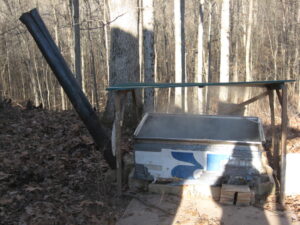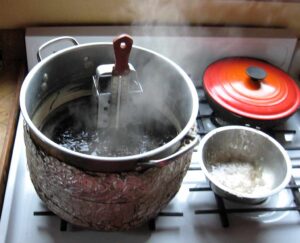- Like
- Digg
- Del
- Tumblr
- VKontakte
- Buffer
- Love This
- Odnoklassniki
- Meneame
- Blogger
- Amazon
- Yahoo Mail
- Gmail
- AOL
- Newsvine
- HackerNews
- Evernote
- MySpace
- Mail.ru
- Viadeo
- Line
- Comments
- Yummly
- SMS
- Viber
- Telegram
- Subscribe
- Skype
- Facebook Messenger
- Kakao
- LiveJournal
- Yammer
- Edgar
- Fintel
- Mix
- Instapaper
- Copy Link
A version of this column first ran in the Roane County (WV) Reporter and Times Record. Support local journalism! Subscribe to your local newspaper.
 Maple syrup may not be produced in a garden, but it is food you can produce on your homestead…as long as you have some maple trees. Ideally this means sugar maple trees; red maples and silver maples do produce sweet sap but it has a lot less sugar in it than sugar maples have. You must boil off 40 gallons of water from sugar maple sap to produce one gallon of maple syrup, and slightly more to make maple sugar. This takes a good bit of firewood and time. So if you use trees that are less concentrated, it will take even more of both. But I’ve heard of sap from sycamores and black walnuts and black birches being used.
Maple syrup may not be produced in a garden, but it is food you can produce on your homestead…as long as you have some maple trees. Ideally this means sugar maple trees; red maples and silver maples do produce sweet sap but it has a lot less sugar in it than sugar maples have. You must boil off 40 gallons of water from sugar maple sap to produce one gallon of maple syrup, and slightly more to make maple sugar. This takes a good bit of firewood and time. So if you use trees that are less concentrated, it will take even more of both. But I’ve heard of sap from sycamores and black walnuts and black birches being used.
A sugar maple may be tapped if it is at least ten to twelve inches in diameter three feet up where you’ll put the tap. A tree that is over eighteen inches can have two taps. I have several trees I tap every year, though the exact itinerary varies as I skip a tree that produced poorly the previous year, and those that require scuttling down a steep bank, if I don’t need them. I have my eye on several small ones that will tappable in a few years.
You need a spile for each tap. This is a metal (well, mine are metal) device that pushes into the hole you’ve drilled (about an inch deep) into the tree, and ends in a spout, which you can poke into a hole near the top of a plastic jug (reduce, reuse!). This is what we used to do but the jugs do sometimes blow off the trees, and the place where the spout pokes into the jug doesn’t have a good seal so at the end of the season (usually in March) bugs get in. What we do now is use clear plastic tubing pushed onto the spout and sealed with electrical tape; the other end goes into a hole in the lid of the jug, also sealed with tape. What I do when I make my rounds is unscrew the cap and fasten it onto an empty jug, place the other lid on the partly full one, and take it back to the house to dump into a five gallon carboy or directly into the 25 gallon stainless steel tank in which we boil down the sap. At least once, the sap should flow through a screen of some kind to filter out any bugs and bark debris.
Sap runs when nights go below freezing and days go above, usually through the month of February and into March. Some people start in January, but I regard that as too early. At the end of the season there may be bugs getting into your jugs, and when the maple buds begin swelling, the sap may begin to develop an off flavor.
If you’re accumulating sap to have enough to be worth starting your boiling operation, how long your jugs of sap can sit depends on the weather. If the temperature stays near freezing, you can go three or four days. If the jugs are sitting on the porch and it’s going into the sixties, two days is the limit.
 There isn’t much to say about boiling down the sap except that it will put off a great deal of steam, so ideally you do it outside or in a basement, perhaps. And that when you get down to about two gallons—if the ultimate quantity will be one gallon—you should do the final part of the operation on the kitchen stove, so you can keep a close eye on it. It’s ready to bottle when a candy thermometer reads 219 degrees. When it cools, you can store the syrup in the refrigerator; if you have a greater quantity than that, it’s not a bad idea to can it, perhaps in pint jars. A fifteen-minute boing water bath will suffice. That way you can store it on a pantry shelf indefinitely. Maple syrup makes a great gift.
There isn’t much to say about boiling down the sap except that it will put off a great deal of steam, so ideally you do it outside or in a basement, perhaps. And that when you get down to about two gallons—if the ultimate quantity will be one gallon—you should do the final part of the operation on the kitchen stove, so you can keep a close eye on it. It’s ready to bottle when a candy thermometer reads 219 degrees. When it cools, you can store the syrup in the refrigerator; if you have a greater quantity than that, it’s not a bad idea to can it, perhaps in pint jars. A fifteen-minute boing water bath will suffice. That way you can store it on a pantry shelf indefinitely. Maple syrup makes a great gift.
This post may be a bit early, but if you’ve decided to give it a try, you’ll have to find some spiles (order them online maybe) and also locate some tappable sugar maple trees. Which may mean you first have to find someone who can tell a sugar maple from a red or silver maple, at a time when there are no leaves. Actually, the difference in bark is more obvious than in the leaves, but silver maple leaves are deeply indented while both red and sugar maple leaves look like the Canadian flag. Red maples have paler, smoother bark till they’re pretty good sized while even two-inch saplings of sugar maples are a darker grey and have coarser, rougher bark.
Do it. Tending your boiling sap while the clouds pass over and the air is laden with mingled scents of woodsmoke and maple syrup is a pleasant chore, and when you’re pouring some of your own syrup on your pancakes, you’ll be glad you did.
Use the comment section for questions, objections and suggestions.
